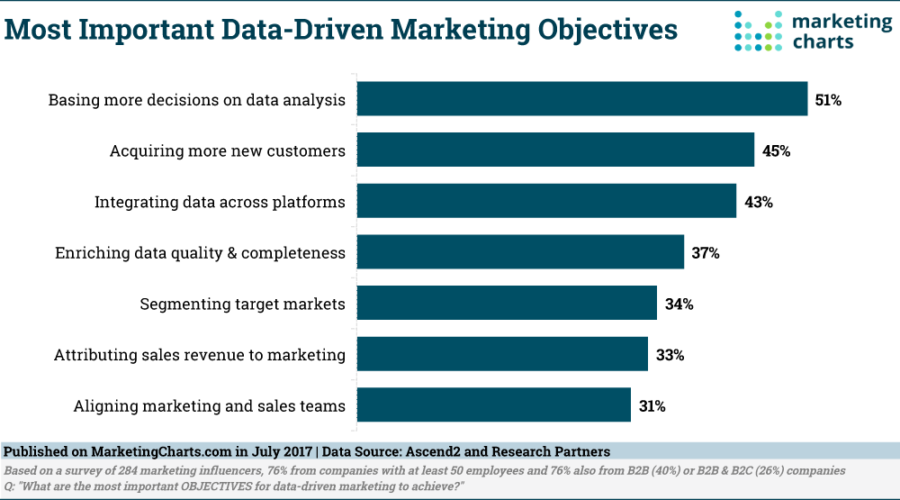With the market becoming more complex and customers demanding a personalized experience, data-driven marketing is the only way forward.
As we head into 2024, marketers are more focused than ever on using data-driven insights to better understand their customers and boost their overall competitive advantage.
Here’s a look at 25+ amazing statistics on the impact of how data will impact marketing success in 2024:
Key Statistics: Data-Driven Marketing
As we advance into 2024, data-driven marketing strategies are becoming indispensable for businesses seeking a deeper connection with their customers. Here’s a glimpse at some compelling statistics that showcase the power of data in marketing:
- Technology and Customer Insights: A significant 33% of elite marketers believe that having the right technologies for data collection and analysis is crucial for understanding customer needs (Econsultancy & IBM). This technological insight allows for a comprehensive view of customer interactions, a challenge identified by the top marketers (Forrester and DMA).
- Enhancing Marketing Objectives: According to a survey by Ascend2, key objectives for marketers include basing more decisions on data analysis (51%), acquiring new customers (45%), and integrating data across platforms (43%). These objectives emphasize the importance of enriched data quality and completeness in shaping marketing strategies.
- Profitability and Competitive Advantage: Marketers leveraging third-party data have noted a marked improvement in targeting precision and content relevance (Forbes). Furthermore, companies adopting data-driven approaches are six times more likely to report year-over-year profitability (Forbes).
25 Data-Driven Marketing Statistics to Keep in Mind
1. 33% of elite marketers say having the right technologies for data collection and analysis is the most useful in understanding customers. (Econsultancy & IBM)
2. Understanding customer interactions across all touchpoints is the #1 challenge for marketers. (Forrester and DMA)
3. 1/3 of marketers identified cross-device ID as a priority in their organization. (Winterberry Group & DMA)
4. 68% say improving ROI measurability is the most important goal for a data management strategy. (Ascend2)

5. The ability to gain a whole view of the customer depends in part on the integration of data from different sources. So which sources are being used to augment data-driven marketing? According to survey by Adobe, the top 3 ways marketers are adding value include the use of CRM data, real-time data from analytics, and by integrating analytics across channels. (Adobe/Marketing Charts)
6. In research by Ascend2 and Research Partners, the most important data-driven marketing objectives cited by marketing professionals include:
- basing more decisions on data analysis (51%)
- acquiring new customers (45%)
- integrating data across platforms (43%)
- and enriching data quality and completeness (37%)
7. 88% of marketers surveyed by Forbes use data obtained by third parties to enhance their understanding of each customer. (Forbes)
8. In the same study by Forbes, 66% of marketing data is used to better focus on targeting offers, messages and content. (Forbes)
9. Companies who adopt data-driven marketing are more likely to have an advantage over the competition and increase profitability. In fact- they are six times more likely to be profitable year-over-year. (Forbes)

10. 64% of marketing executives “strongly agree” that data-driven marketing is crucial in the economy. (Forbes)
11. GlobalDMA found that 49% of marketers use data to enhance customer experience. (GlobalDMA)
13. According to CMO, 67% of marketers believe speed is one of the primary benefits of data-driven marketing, resulting in the ability to execute their campaigns quickly. (CMO Council)
14. 44% of marketers say that increasing revenue due to marketing is their top goal. (Ascend2)
15. Research by CMO Council showed that an inadequate budget was the biggest obstacle for marketers to start using data-driven customer strategies. (CMO Council)
16. Customers expect companies to recognize and engage with them in real-time. Unfortunately, few marketers are able to act this quickly. In the study by CMO Council, 7% of survey respondents say they’re always able to deliver real-time, data-driven experiences across physical and digital touchpoints.
And while 52% of respondents say they can deliver some of these experiences, they can only do so via marketing-owned (28%) or mainly digital channels (24%). (CMO Council)

17. Last year, more than 63% of marketers reported they have increased their spending on data-driven marketing, and around 20% of all marketing spend goes on data-driven advertising campaigns. (Digital Doughnut)
18. One-third of industry professionals highlight that the right technologies for data collection and analysis are essential for better understanding of customers. Currently, 44% of marketers say they have data management platforms, and 33% are planning to have one. (Digital Doughnut)
19. According to Sitecore, brands report harvesting an average of eight pieces of data, ranging from more transactional details to behavioral insights and trends. The most common types of customer data that respondents’ brands collect online are: Email address (89%), Name (84%), Telephone number (75%), Physical address (68%).
In their on-going quest to know customers better, some respondents’ brands are delving deeper: Through purchasing (47%), Browsing (31%), Histories down to devices used (30%), Social media habits (27%), Real-time geolocation (21%)
Many brand respondents in SiteCore’s survey report internal technical hurdles to becoming a data-driven organization including: 42% have a lack of integration between data collection apps, 20% do not have the technology to collect online customer data, 15% do not have the technology to store it.
20. Many marketers struggle with the amount of real-time insights they can access. Only the minority can react to online customer interactions immediately – 43% in the pre-purchase stage, 38% during purchase, and just 35% post-purchase.
31% lack the in-house skills to analyze the data, Just 12% have data at an individual customer level (vs. segment or demographic group), 65% of brand respondents’ organizations are using digital analytics software, with 30% only planning to adopt it. (SiteCore)
21. Data enables marketers to pinpoint the exact moment a message is most relevant to a consumer. People receive between 300 and 3000 marketing messages a day, but can only retain a maximum of three – if you’re not serving personalized content at the most relevant, receptive moment for that consumer, you’re wasting resources and losing opportunities.

22. In fact, 52% of consumers (and 65% of B2B buyers) say they’re likely to switch brands if a company doesn’t personalize communications to them. But brands can only personalize effectively if they know who their customers are – their information, behaviors and preferences. A CRM platform is critical in tracking and using this data. (Salesforce)
23. 57% of consumers are willing to share personal data in exchange for personalized offers or discounts. A similar proportion will share their data in exchange for product recommendations that meet their needs (52%) and personalized shopping experiences (53%). (Salesforce)
24. Nearly two-thirds (62%) of consumers say it’s acceptable for companies to send personalized offers and discounts based on items they’ve already purchased. (Salesforce)
25. 89.6 percent of survey panelists in research by MediaMath said that their practice of data-driven marketing and advertising was focused, at least in part, on the maintenance of customer and prospect databases—with those resources typically aimed at supporting better and more relevant offers and general customer communications. (MediaMath)
Wrapping Up
By now, it’s clear that data-driven marketing isn’t just a trend—it’s a fundamental aspect of successful marketing strategies.
The ability to harness and analyze customer data accurately allows businesses to not only understand their audiences better but also to significantly enhance their engagement and profitability.
With technology continuing to evolve, the potential for data to empower marketers and transform business models will only increase.

